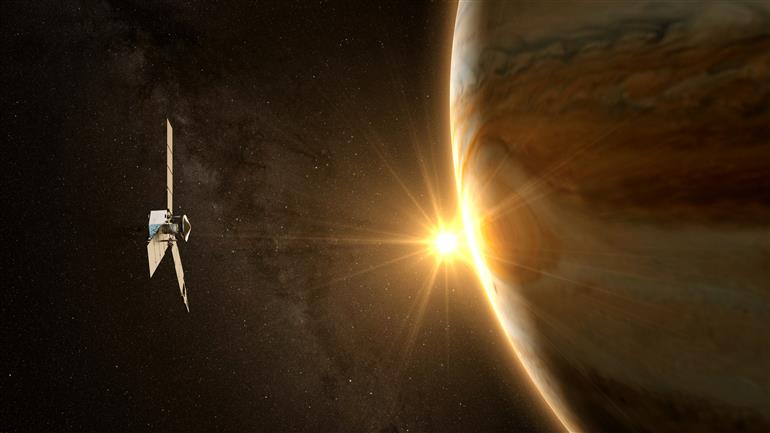Washington, June 4
NASA’s Juno spacecraft will certainly come within 645 miles (1,038 kilometres) of the surface area of Jupiter’s biggest moon, Ganymede on June 7, the United States room company claimed on Friday.
The solar-powered Juno spacecraft will fly previous Ganymede at 1: 35 pm EDT (10: 35 am PDT). The flyby will certainly be the closest-known because NASA’s Galileo spacecraft made its penultimate close method back on May 20, 2000.
.
The flyby will certainly generate striking understandings right into the Moon’s structure, ionosphere, magnetosphere, and also ice covering. Juno’s dimensions of the radiation atmosphere near the Moon will certainly additionally profit future objectives to the Jovian system– incorporating Jupiter, its rings and also moons, NASA claimed.
.
Ganymede is larger than the world Mercury and also is the only moon in the planetary system with its very own magnetosphere– a bubble-shaped area of billed bits bordering the heavenly body.
” Juno lugs a collection of delicate tools with the ability of seeing Ganymede in means never ever prior to feasible,” claimed Scott Bolton, Juno Principal Detective of the Southwest Study Institute in San Antonio.
” By flying so close, we will certainly bring the expedition of Ganymede right into the 21 st century, both enhancing future objectives with our special sensing units and also assisting plan for the future generation of objectives to the Jovian system– NASA’s Europa Clipper and also ESA’s (European Area Firm’s) JUpiter ICy moons Traveler [JUICE] objective,” Bolton claimed.
The Europa Clipper is slated for a launch in October 2024 and also anticipated to show up in April 2030, while JUICE is prepared for launch in 2022 and also arrival at Jupiter in 2029.
Additionally, Juno’s Excellent Referral System (SRU) navigating electronic camera will certainly assist maintain the Jupiter orbiter on program. It will certainly additionally collect info on the high-energy radiation atmosphere in the area near Ganymede by accumulating an unique collection of pictures.
On The Other Hand, the Advanced Stellar Compass electronic camera will certainly count really energised electrons that permeate its protecting with a dimension every quarter of a 2nd. As well as the JunoCam imager will certainly gather pictures at a resolution matching to the very best from Voyager and also Galileo.
As a result of the rate of the flyby, the icy moon will certainly– from JunoCam’s perspective– go from being a factor of light to a readable disk, after that back to a factor of light in around 25 mins. To ensure that’s simply sufficient time for 5 pictures, NASA claimed.
” Points normally take place quite fast worldwide of flybys, and also we have 2 back-to-back following week. So essentially every 2nd matters,” claimed Juno Goal Supervisor Matt Johnson of JPL.
” On Monday, we are mosting likely to race past Ganymede at virtually 12 miles per 2nd (19 kilometres per secondly). Much less than 24 hrs later on we’re executing our 33 rd scientific research pass of Jupiter– shouting reduced over the cloud tops, at concerning 36 miles per 2nd (58 kilometres per secondly). It is mosting likely to be a wild flight,” he included. IANS
